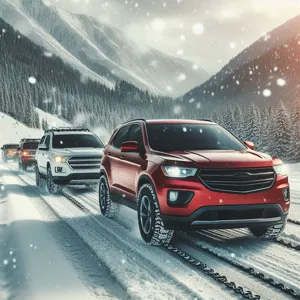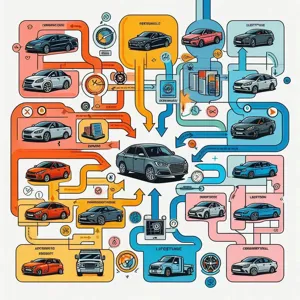When it comes to selecting the perfect vehicle, many drivers focus on style, features, and price, often overlooking a crucial factor: climate.
The environment in which you live can dramatically influence not only your driving experience but also the longevity and performance of your car. Whether you’re navigating through snowy winters or sweltering summers, understanding how climate impacts your vehicle choice is essential for ensuring comfort, safety, and efficiency. In this blog post, we’ll guide you through the key considerations for selecting a car that aligns perfectly with your local weather conditions. From all-wheel drive systems that handle icy roads to efficient air conditioning for those blistering hot days, we’ll explore the best options available to help you drive smart, no matter what Mother Nature throws your way. Get ready to make an informed decision that suits both your lifestyle and the climate you call home!
1. Understanding the Impact of Climate on Your Vehicle

When it comes to selecting the perfect car, one of the most critical factors to consider is the climate in which you’ll be driving. The environment you live in can drastically affect not only your driving experience but also the maintenance and longevity of your vehicle. Understanding the impact of climate on your car can help you make an informed decision, ensuring that your investment thrives in the conditions it will face daily.
In hot, arid climates, for instance, vehicles are often subjected to intense sunlight and high temperatures. This can lead to quicker wear and tear on components such as tires and batteries, which may degrade faster under extreme heat. Cars that feature robust cooling systems and sun-resistant materials can provide a more comfortable driving experience and require less maintenance over time. Additionally, consider models with tinted windows or UV-resistant coatings to protect both the interior and exterior from sun damage.
Conversely, if you reside in a region with cold winters and heavy snowfall, your vehicle’s ability to handle icy roads and frigid temperatures becomes paramount. All-wheel drive or four-wheel drive vehicles are often ideal for such climates, providing better traction and stability on slippery surfaces. Furthermore, cars equipped with heated seats, steering wheels, and advanced defrosting systems can significantly enhance comfort during those chilly commutes.
Additionally, the impact of humidity can’t be overlooked. In areas with high moisture levels, vehicles may be more susceptible to rust and corrosion, especially if they are not made with weather-resistant materials. It’s essential to choose models that offer superior protection against rust and to consider additional protective measures, such as regular undercoating treatments.
Ultimately, understanding how climate influences vehicle performance and durability will empower you to select a car that not only meets your personal preferences but also stands up to the environmental challenges it will face. By aligning your vehicle choice with the demands of your local climate, you’ll ensure a smoother, safer, and more enjoyable driving experience for years to come.
2. Key Climate Considerations: Hot, Cold, and Humid Conditions
When it comes to choosing the right car for your climate, understanding the specific environmental conditions you’re up against is crucial. different climates pose unique challenges that can significantly impact your vehicle’s performance, comfort, and longevity. Let’s explore the key considerations for hot, cold, and humid conditions so you can make an informed decision.
In hot climates, the blazing sun can wreak havoc on your car’s exterior and interior. Opt for vehicles with UV-resistant paint and dark-tinted windows to protect against sun damage. Look for models equipped with robust air conditioning systems that can keep you cool during the scorching summer months. Additionally, consider cars with high ground clearance, as they are less likely to suffer from heat-related issues like tire blowouts on hot asphalt.
Conversely, if you live in a cold climate, your car needs to be equipped to handle frigid temperatures and icy conditions. All-wheel drive or four-wheel drive systems are essential for maintaining traction on slick roads. A vehicle with a powerful battery and a reliable heating system will ensure you can start your engine in sub-zero temperatures and stay warm while waiting for the cabin to heat up. Also, consider cars with features like heated seats and steering wheels to enhance comfort during the chilly winter months.
For those residing in humid climates, the constant moisture in the air can lead to unique challenges, such as mold growth and rust. Choosing a car with good ventilation and air conditioning is vital to combat the muggy conditions. Look for vehicles that have anti-corrosion coatings and materials that can withstand the effects of humidity. Additionally, features like a sunroof may be appealing for those who enjoy a breeze, but consider how often you’ll actually want to use it in the sweltering heat.
By taking these climate-specific factors into account, you can ensure that your vehicle not only fits your lifestyle but also stands up to the elements, providing you with a safe, comfortable, and reliable driving experience year-round.
3. Choosing the Right Fuel Type for Your Climate

When it comes to selecting the right car for your climate, one of the most crucial factors to consider is the fuel type. The fuel your vehicle consumes can significantly impact its performance, efficiency, and overall suitability for the environmental conditions you face on a daily basis.
In colder climates, gasoline engines typically perform better than diesel. Gasoline vehicles tend to start more easily in frigid temperatures, where diesel engines can struggle and may require additional additives to prevent fuel from gelling. Furthermore, gasoline engines often have a more responsive throttle, providing quick acceleration when navigating icy or snowy roads. On the other hand, diesel engines are known for their durability and fuel efficiency, making them a great choice for drivers who frequently travel long distances in moderate climates, but they may require extra precautions in extreme cold.
Conversely, in hotter regions, the choice between gasoline and diesel can lean toward diesel due to its superior fuel efficiency and power, especially for heavy-duty tasks like towing. However, gasoline engines often come with lower initial costs and are less prone to overheating in extreme heat compared to their diesel counterparts.
Additionally, consider hybrid and electric vehicles as alternatives, especially in urban environments where stop-and-go traffic is prevalent. These vehicles do well in warmer climates where longer ranges can be enjoyed without the fear of rapid battery drainage from extreme cold. However, be mindful of the local infrastructure for charging stations, as it can vary significantly by region.
Ultimately, choosing the right fuel type for your climate involves assessing your driving habits and understanding how different fuels interact with local weather conditions. By aligning your vehicle choice with the climate you live in, you’ll enhance your driving experience and ensure that your car performs optimally, no matter the season.
4. The Importance of All-Wheel Drive vs. Front-Wheel Drive
When choosing the right car for your climate, understanding the differences between all-wheel drive (AWD) and front-wheel drive (FWD) is crucial. Each drivetrain has its own set of advantages and disadvantages, and selecting the right one can significantly enhance your driving experience, particularly in challenging weather conditions.
All-wheel drive systems are designed to distribute power to all four wheels simultaneously, providing superior traction and stability on slippery surfaces such as snow, ice, or wet roads. For those living in regions with harsh winters or frequent rain, an AWD vehicle offers peace of mind, allowing you to navigate through difficult conditions with confidence. The added grip and control can be a game-changer, especially when accelerating from a stop or tackling steep inclines after a heavy snowfall.
On the other hand, front-wheel drive vehicles, which direct power to the front wheels only, can be a more economical choice for drivers in milder climates. FWD cars typically offer better fuel efficiency, which can translate to cost savings over time. They are also generally less complex in their design, resulting in lower maintenance costs. However, in inclement weather, FWD may not perform as well as AWD, especially when faced with deep snow or icy roads, where the rear wheels are left to drift.
Ultimately, the choice between all-wheel drive and front-wheel drive should be influenced by the typical weather conditions you encounter. If your area experiences heavy snowfall, icy roads, or rugged terrain, investing in an AWD vehicle is likely worth the added expense. Conversely, if you reside in a temperate climate with mild winters, a front-wheel drive vehicle may serve you just fine, providing a balance of efficiency and manageable performance.
In summary, consider your local weather patterns, driving habits, and budget when deciding between AWD and FWD. Making an informed choice will not only enhance your driving safety but also ensure you enjoy the journey, regardless of the climate.
5. Assessing Engine Performance in Different Weather Conditions

When choosing a car that can handle the whims of your local climate, assessing engine performance in various weather conditions is crucial. Different engines respond uniquely to temperature fluctuations, humidity levels, and even altitude, impacting everything from fuel efficiency to overall reliability.
In colder climates, for instance, it’s essential to consider how an engine performs during frigid temperatures. Many vehicles struggle to start in extreme cold due to thickened engine oil and reduced battery efficiency. Look for cars equipped with features like block heaters, which warm the engine and make cold starts easier. Additionally, vehicles with turbocharged engines tend to perform better in low temperatures since they can generate power more efficiently, even when the air is denser.
Conversely, in hot and humid environments, engine cooling becomes a priority. Engines that lack proper cooling systems may overheat, leading to catastrophic failures. Consider cars with robust cooling systems, including larger radiators and higher-capacity cooling fans. Also, engines that utilize synthetic oil can be advantageous in hot climates, as they maintain viscosity better under high temperatures and help prevent wear.
Moreover, the type of fuel used can also play a role in engine performance across climates. In high-altitude areas, for example, air density decreases, which can affect engine efficiency and power output. In such cases, turbocharged engines are often preferred, as they can compensate for the reduced oxygen levels, delivering power without sacrificing performance.
Ultimately, understanding how different engines react to various weather conditions can help you make an informed choice. Keep in mind that your car should not only perform well in ideal circumstances but also be dependable when faced with the challenges posed by your local climate. By selecting a vehicle with proven engine performance metrics suited to your environmental conditions, you can ensure a smoother, safer, and more enjoyable driving experience year-round.
6. Selecting Tires Suitable for Various Climates
When it comes to choosing the right car for your climate, one of the most crucial factors often overlooked is the selection of tires. Tires are the only point of contact between your vehicle and the road, and their performance can significantly affect your driving experience, fuel efficiency, and, most importantly, safety. Different climates demand different tire types, and understanding these needs can make all the difference in your driving performance and comfort.
In warmer climates, where the sun shines brightly and temperatures soar, all-season tires are typically a popular choice. These tires are designed to provide a balanced performance in both wet and dry conditions, offering improved traction without sacrificing durability. However, if you live in an area where temperatures consistently exceed 100 degrees Fahrenheit, consider investing in summer tires. These tires are formulated with a specific rubber compound that performs optimally in high heat, providing better grip and handling on hot pavement.
Conversely, if your region experiences harsh winters with snow and ice, winter tires are an absolute must. Designed with deeper treads and softer rubber compounds, winter tires are engineered to maintain flexibility in low temperatures, allowing for enhanced traction and stability on slippery surfaces. They can significantly reduce your stopping distance on snow-covered roads, making your commute safer and more predictable.
For those who face a mix of both conditions, consider all-terrain or mud-terrain tires if you frequently venture off the beaten path. These tires are built to handle rough terrains, providing a rugged tread pattern that can grip loose surfaces like gravel and mud while still performing adequately in light snow.
Additionally, remember to regularly check the tire pressure and tread wear, as fluctuating temperatures can affect tire inflation and performance. Keeping your tires properly maintained not only prolongs their lifespan but also ensures that your vehicle performs optimally, no matter what climate challenges you face. By choosing the right tires for your specific climate, you can drive with confidence, knowing that you’re prepared for whatever Mother Nature throws your way.
7. The Role of Air Conditioning and Heating Systems

When selecting the right car for your climate, one of the most crucial aspects to consider is the efficiency and effectiveness of the air conditioning and heating systems. These systems not only influence your comfort but can also significantly impact the overall performance and safety of your vehicle.
In hot climates, a robust air conditioning system is vital. Look for vehicles that feature multi-zone climate control, which allows for different temperature settings in various areas of the car. This is particularly important for families or anyone who often shares their ride with others, ensuring that everyone stays comfortable during long drives. Additionally, consider cars with tinted windows or sunshades to further shield against the harsh sun, as these features work in tandem with the A/C to keep the interior cool and pleasant.
Conversely, in colder climates, an effective heating system is essential for maintaining a cozy environment during the frigid months. Look for vehicles equipped with heated seats and steering wheels, which can add a layer of comfort and warmth during icy commutes. Furthermore, consider models that boast excellent insulation to minimize heat loss, allowing the cabin to stay warm longer without over-reliance on the heating system.
Don’t overlook the importance of defrosting capabilities either. In regions where frost and snow are common, a car that quickly clears the windshield and rear window can enhance visibility and safety while driving in winter conditions.
Finally, regular maintenance of your vehicle’s heating and air conditioning systems cannot be understated. Ensuring that these systems are in optimal working condition will not only enhance your driving experience but also prolong the life of your vehicle.
By taking the time to evaluate the air conditioning and heating features of any potential car purchase, you can ensure that you select a vehicle that will keep you comfortable and safe, no matter what the weather throws your way.
8. Evaluating Weatherproof Features in Cars
When choosing a car that can withstand the whims of your local climate, evaluating weatherproof features is paramount. Different environments present unique challenges, from snow-laden winters to searing summer heat, and the right vehicle should be equipped to handle these conditions with ease.
Start by considering the essential features that enhance a car’s resilience against weather elements. For regions plagued by heavy rainfall, look for vehicles with advanced water drainage systems and sealed door frames to prevent leaks and water intrusion. A robust windshield wiper system, complete with heated wipers in colder climates, ensures that visibility remains clear during the downpours.
For those residing in areas with harsh winter conditions, all-wheel drive (AWD) or four-wheel drive (4WD) is a game-changer. These systems provide superior traction on slippery roads, allowing you to navigate through snow and ice with confidence. Additionally, heated seats and steering wheels can turn a frigid morning commute into a cozy ride, making those early drives much more pleasant.
Conversely, if you live in a region known for scorching summers, prioritize features that combat heat. Look for vehicles with effective climate control systems, tinted windows, and a well-insulated cabin to keep the interior cool and comfortable. Sunroofs and panoramic roofs can also be appealing, but ensure they come with quality sunshades to block out the intense rays during peak hours.
In addition to these specific features, consider the materials used in the vehicle’s construction. Rust-resistant coatings and durable exterior finishes are essential for combating the corrosive effects of road salt in winter or humidity in tropical climates. leather and synthetic upholstery may be easy to clean but can heat up quickly, so opting for breathable fabric seats can enhance comfort during those hot sunny days.
Ultimately, evaluating weatherproof features in a car goes beyond mere aesthetics; it’s about ensuring safety, comfort, and longevity. By taking the time to assess these aspects before making a purchase, you’ll be better equipped to select a vehicle that not only meets your driving needs but also seamlessly adapts to the climate challenges of your region.
9. Safety Features for Extreme Weather Conditions
When selecting a car tailored to your climate, safety features should be at the forefront of your decision-making process, especially in regions prone to extreme weather conditions. The right vehicle can mean the difference between a smooth, safe journey and a harrowing experience when faced with rain, snow, ice, or intense heat.
For snowy and icy climates, look for vehicles equipped with all-wheel drive (AWD) or four-wheel drive (4WD) systems. These features enhance traction by distributing power to all wheels, ensuring better grip on slippery surfaces. Additionally, vehicles with advanced traction control systems can help prevent wheel slip during sudden accelerations or deceleration, making them invaluable during winter storms.
In regions that experience heavy rainfall and flooding, having a car with excellent visibility features is crucial. Opt for vehicles that come with advanced windshield wipers, fog lights, and rearview cameras. These elements improve your ability to see and be seen, significantly reducing the chances of accidents in poor visibility conditions. Furthermore, consider anti-lock braking systems (ABS), which prevent the wheels from locking up during hard braking, allowing for better control on wet roads.
For hot climates, it’s essential to prioritize cooling safety features. Look for cars with effective air conditioning systems, ventilated seats, and tinted windows to protect against the sun’s harsh rays. Additionally, modern vehicles often come equipped with tire pressure monitoring systems (TPMS) that alert you to any tire issues, which can be exacerbated by high temperatures.
Lastly, consider vehicles with comprehensive safety packages that include features such as lane departure warnings, adaptive cruise control, and automatic emergency braking. These technologies are designed to assist drivers in maintaining control and reacting swiftly to unexpected situations, no matter the weather.
In summary, choosing a car with the right safety features for extreme weather conditions not only enhances your comfort but can also significantly reduce the likelihood of accidents. By prioritizing these attributes, you’ll ensure that you and your passengers stay safe, no matter what Mother Nature throws your way.
10. Maintenance Tips for Cars in Different Climates
Maintaining your vehicle is crucial, especially when navigating the diverse challenges posed by different climates. Understanding how your car reacts to its environment can significantly extend its lifespan and enhance performance. Here are some tailored maintenance tips for various weather conditions to ensure your ride remains in top shape year-round.
**In Hot Climates:**
High temperatures can take a toll on your vehicle’s engine and tires. Ensure that your cooling system is functioning optimally by regularly checking the coolant levels and inspecting hoses for cracks or leaks. Additionally, consider using synthetic oil, which can withstand higher temperatures better than conventional oil. Don’t forget to check your tire pressure frequently; heat can cause air to expand, leading to over-inflation and increased wear. Lastly, a sunshade for your windshield can protect your interior and keep your car cooler when parked.
**In Cold Climates:**
Winter weather demands a specific focus on your vehicle’s battery, tires, and fluids. Cold temperatures can drain battery power more quickly, so make sure your battery is in good condition and consider investing in a battery warmer if you live in an area that experiences extreme cold. Opt for winter tires that provide better traction on icy roads, and don’t skimp on checking the tread depth. In addition, use winter-grade oil that flows better in low temperatures, and keep an eye on your antifreeze levels to prevent your engine from freezing.
**In Humid Climates:**
Humidity can lead to rust and corrosion, making it essential to regularly wash your car, especially the undercarriage, to remove salt and grime that can accumulate. Invest in a high-quality wax to provide a protective barrier against moisture. Ensure that the air conditioning system is functioning properly to help reduce humidity inside the vehicle. Additionally, keep an eye on your wiper blades and windshield washer fluid, as heavy rain and storms can obscure visibility.
By tailoring your maintenance routine to the climate you live in, you can ensure your vehicle remains reliable and efficient, no matter the weather. Regular inspections and timely interventions can save you from costly repairs down the line and keep your driving experience smooth and enjoyable throughout the seasons.
11. Comparing Sedans, SUVs, and Trucks by Climate Suitability
When it comes to selecting the right vehicle for your climate, understanding the unique advantages and drawbacks of sedans, SUVs, and trucks is crucial. Each type of vehicle offers distinct features that can enhance your driving experience depending on the weather conditions you’ll face regularly.
**Sedans** are often regarded as the ideal choice for urban environments and temperate climates. With their lower profiles and streamlined designs, sedans typically offer better fuel efficiency and handling on smooth, paved roads. They excel in conditions where snow and ice are minimal, thanks to their lighter weight and responsive steering. However, in heavy rain or unexpected flooding, sedans may struggle, as their lower clearance can make them susceptible to hydroplaning. If you live in a climate with mild winters and occasional rain, a sedan can be a stylish and economical option.
On the other hand, **SUVs** are designed for versatility and adaptability, making them a favorite in regions with variable weather. With higher ground clearance, all-wheel drive options, and ample cargo space, SUVs handle well in snowy and rugged conditions. They provide a commanding view of the road, which can enhance safety and confidence while driving in adverse weather. Additionally, many modern SUVs come equipped with advanced technology to assist with traction and stability during slippery conditions. For families or individuals living in areas prone to harsh winters or off-road adventures, an SUV may offer the perfect balance of comfort and capability.
Lastly, **trucks** are the heavyweights of the vehicle family, built to withstand the toughest of climates and terrains. Their robust construction and powerful engines make them ideal for towing and hauling, which is particularly beneficial for those living in rural areas or climates with significant snowfall. Trucks often come with four-wheel drive options, making them highly capable in icy or off-road conditions. However, they may lack the fuel efficiency of sedans and some SUVs, and their size can make navigating tight city streets challenging. If your lifestyle involves outdoor activities, heavy lifting, or traversing rugged landscapes, a truck could be your best ally against the elements.
In conclusion, when comparing sedans, SUVs, and trucks, consider not just the climate you live in but also your lifestyle needs. Each vehicle type has its strengths and weaknesses, so taking the time to evaluate how these factors align with your daily driving conditions will lead you to a smarter, more satisfying choice.
12. Eco-Friendly Options for Your Climate
When it comes to selecting a car that aligns with eco-friendly practices, it’s essential to consider the specific climate in which you live. Different environments present unique challenges and opportunities for green driving, influencing the type of vehicle that can best meet your needs while minimizing environmental impact.
In urban areas with heavy traffic and frequent stop-and-go conditions, hybrid vehicles can be an excellent choice. These cars combine a traditional gasoline engine with an electric motor, optimizing fuel efficiency and reducing emissions during short trips and in congested traffic. The ability to switch to electric power at lower speeds means that in such bustling environments, hybrids often outperform their gas-only counterparts.
For those living in regions with milder climates, fully electric vehicles (EVs) shine brightly. Without the need for an internal combustion engine, these cars produce zero tailpipe emissions, making them ideal for eco-conscious drivers. Furthermore, many areas offer incentives for EV purchases or have extensive charging networks, making it easy to maintain a sustainable driving habit.
However, if you reside in colder climates where winter conditions can be harsh, it’s important to pay attention to battery performance in frigid temperatures. Some EVs are engineered with heat management and battery insulation, making them more reliable in the cold. Additionally, consider vehicles that utilize renewable energy sources, such as solar panels, to further reduce your carbon footprint.
Finally, if your lifestyle involves frequent outdoor adventures or off-road excursions, explore eco-friendly SUVs or crossovers designed with sustainable materials and efficient engines. Some manufacturers are now producing rugged vehicles that combine low emissions with the capability to navigate diverse terrains, ensuring that your love for the great outdoors doesn’t come at the expense of the environment.
In conclusion, choosing an eco-friendly vehicle tailored to your climate not only supports sustainability but also enhances your driving experience. By considering the unique challenges posed by your environment, you can drive smartly while contributing positively to the planet.
13. Real-World Examples: Cars Best Suited for Specific Climates
When it comes to selecting the perfect vehicle for your climate, understanding real-world examples can provide invaluable insight. Different regions present unique challenges and demands for vehicles, and some models have been specifically engineered to excel in these environments. Here’s a look at a few cars that stand out based on distinct climatic conditions.
**1. Snowy Mountains: Subaru Outback**
For those living in regions with heavy snowfall and icy roads, the Subaru Outback is a top contender. Renowned for its all-wheel drive capabilities and robust ground clearance, the Outback can tackle winter conditions with ease. Its symmetrical all-wheel drive system ensures optimal traction, making it a reliable choice for navigating snow-laden roads and steep inclines. Additionally, the car’s heated seats and advanced climate control features provide comfort during the cold months.
**2. Hot Deserts: Toyota RAV4 Hybrid**
In scorching desert climates where temperatures can soar, the Toyota RAV4 Hybrid emerges as a prime option. With its fuel-efficient hybrid engine, this compact SUV offers excellent gas mileage, allowing drivers to save on fuel costs while enduring the heat. The RAV4’s spacious cabin and superior air conditioning system ensure a cool ride, while its high ground clearance is perfect for navigating sandy terrain. Plus, the vehicle’s reliability and low maintenance make it a smart choice for long drives through arid landscapes.
**3. Rainy Regions: Honda CR-V**
For areas prone to heavy rainfall and wet conditions, the Honda CR-V is an exemplary choice. This compact SUV features a well-designed drainage system and excellent visibility, which are crucial for driving safely in downpours. Its all-wheel-drive option provides enhanced stability on slippery roads, while the spacious interior and cargo capacity cater to families or individuals needing ample storage. The CR-V’s durable materials and easy-to-clean interiors also make it a practical choice for dealing with muddy shoes and wet gear.
**4. Humid Climates: Mazda CX-5**
In regions with high humidity and frequent rain, the Mazda CX-5 is a stylish and functional option. This compact crossover offers a finely tuned air conditioning system that combats muggy weather, ensuring all passengers stay comfortable. With its sleek design and sporty performance, the CX-5 doesn’t just perform well in humid conditions; it also turns heads on the road. The vehicle’s advanced safety features and responsive handling make it an enjoyable ride, no matter the weather.
These examples illustrate how specific vehicles are tailored to meet the demands of varied climates. When choosing your next car, consider these real-world applications to ensure you select a model that will not only enhance your driving experience but also keep you safe and comfortable in your local weather conditions. By understanding the strengths of different vehicles in relation to your climate, you can make a more informed decision that suits your lifestyle and environment.
14. Budgeting for Climate-Appropriate Features
When selecting a car that suits your climate, budgeting for climate-appropriate features is a crucial step that can significantly enhance your driving experience and safety. It’s not just about picking a model that looks good or has the latest tech; it’s about ensuring that your vehicle can withstand and thrive in the environmental conditions you face daily.
First, consider the climate of your region—do you live in a sunny desert, a snowy mountain town, or a rainy coastal area? Each of these environments has specific needs that should dictate your budgetary considerations. For instance, if you reside in a place that experiences heavy snowfall, investing in all-wheel drive (AWD) or four-wheel drive (4WD) can be invaluable. While these features may add to the initial cost, they offer peace of mind and improved handling during treacherous winter months.
On the other hand, if you live in a hot climate, features such as robust air conditioning and heat-reflective window tinting should be prioritized. A car with excellent insulation against the heat can keep your vehicle cooler and reduce the strain on the air conditioning system, ultimately saving you money on fuel and maintenance in the long run.
Additionally, consider the car’s materials and build quality. For coastal areas prone to humidity and salt corrosion, investing in a vehicle with rust-resistant coatings or stainless-steel components can prevent costly repairs down the line. Similarly, UV-resistant interiors can help maintain the car’s aesthetic, preventing fading and cracking over time.
Don’t forget about fuel efficiency as well. In regions with harsh winters or sweltering summers, a fuel-efficient car can save you money and reduce your carbon footprint. Look for vehicles with robust engines that still prioritize efficiency, as these can handle extreme conditions while being gentle on your wallet.
In conclusion, budgeting for climate-appropriate features is more than just an added expense—it’s a strategic investment in a vehicle that aligns with your lifestyle and environment. By thoughtfully considering your climate’s demands, you can choose a car that not only meets your needs but also provides long-term value and satisfaction.
15. Conclusion: Making an Informed Decision for Your Driving Environment
In conclusion, choosing the right car for your climate is a multifaceted decision that goes beyond mere aesthetics or brand loyalty. It’s about understanding the unique demands of your environment and selecting a vehicle that will not only meet your practical needs but also enhance your overall driving experience. Whether you reside in a region plagued by heavy snowfall, relentless heat, or torrential rain, the right car can significantly impact your safety, comfort, and convenience on the road.
As you weigh your options, consider factors such as vehicle size, fuel efficiency, drivetrain, and features specifically designed for your climate. For instance, all-wheel drive may be essential for navigating icy roads, while a robust air conditioning system and sunroof might be more desirable in hot, sunny areas. Additionally, don’t underestimate the importance of tires suited to your climate, as they can make a world of difference in handling and safety.
It’s also wise to take the time to research and test drive various models, paying attention to reviews and feedback from other drivers in similar climates. Engage with local automotive experts or communities to gain insights that can guide your decision-making process.
Ultimately, the right car can serve as a reliable partner in navigating the challenges posed by your climate, providing you with peace of mind and a sense of security. By making an informed choice, you can ensure that your vehicle is not just a mode of transportation but an extension of your lifestyle, perfectly tailored to the environment in which you live and drive.
In conclusion, choosing the right car for your climate is a critical decision that can greatly enhance your driving experience and ensure your safety on the road. By considering factors such as weather conditions, fuel efficiency, and the vehicle’s capabilities, you can make an informed choice that aligns with your lifestyle and environment. Whether you’re navigating snowy streets or cruising through sunny highways, the right car can make all the difference. We hope this guide has provided you with valuable insights and practical tips to help you select a vehicle that not only meets your needs but also complements the climate you live in. Happy driving, and may your journeys be smooth, safe, and enjoyable, no matter the weather!




































